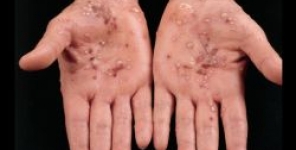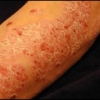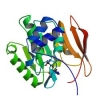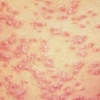È possibile che il polimorfismo 54 del codone MBL2 giochi un ruolo nella patogenesi della psoriasi?
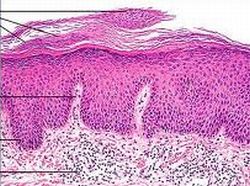 La psoriasi è una malattia immunitaria mediata dalle cellule T nella quale sono coinvolte molte citochine, in primo luogo il fattore di necrosi tumorale-α (TNF-α). I polimorfismi del gene che codifica per la lectina legante il mannosio (MBL) diminuiscono i livelli sierici di MBL, aumentando così la sintesi delle citochine proinfiammatorie, come TNF-α.
La psoriasi è una malattia immunitaria mediata dalle cellule T nella quale sono coinvolte molte citochine, in primo luogo il fattore di necrosi tumorale-α (TNF-α). I polimorfismi del gene che codifica per la lectina legante il mannosio (MBL) diminuiscono i livelli sierici di MBL, aumentando così la sintesi delle citochine proinfiammatorie, come TNF-α.
Obiettivi: Questo studio è stato progettato per valutare il ruolo del polimorfismo 54 del codone MBL2 nella patogenesi della psoriasi.
Metodi: Cinquanta pazienti con diagnosi di psoriasi volgare e 53 soggetti sani sono stati inclusi nello studio. Il metodo della reazione a catena del polimorfismo da lunghezza dei frammenti di restrizione (PCR-RFLP) è stato applicato per determinare il polimorfismo 54 del codone MBL2. Sono stati determinati i genotipi secondo le bande formate in gel elettroforetico di agarosio. Per l'analisi statistica, è stato fissato il livello di significatività a P <0.05.
Risultati: In un totale di 33 (66.0%) su 50 pazienti affetti da psoriasi è stato rilevato il genotipo A/A e in 17 (34.0%) avevano il genotipo B/B. Tra i soggetti di controllo, 44 (83.0%) aveva il genotipo A/A e nove (17.0%) avevano il genotipo B/B. C'è stata una differenza statisticamente significativa tra i due gruppi (P = 0.047). L'analisi delle frequenze alleliche ha rivelato che le prevalenze dell'allele A sono state 79 (79.0%) e 95 (89.6%), e le prevalenze dell'allele B sono state 21 (21.0%) e 11 (10.4%), nel gruppo dei pazienti e in quello dei controlli rispettivamente. È stata rilevata una differenza statisticamente significativa tra le frequenze alleliche (P = 0.031).
Conclusioni: Questo studio suggerisce che il polimorfismo 54 del codone MBL2 può avere un'associazione con la psoriasi, nella popolazione Turca.
Storia della pubblicazione:
Titolo: Does MBL2 codon 54 polymorphism play a role in the pathogenesis of psoriasis?
Rivista: International Journal of Dermatology. doi: 10.1111/j.1365-4632.2012.5657.x
Autori: Hakan Turan, Mutlu Karkucak, Tahsin Yakut, Mustafa Ozsahin, Zehra Gurlevik, Mehmet Emin Yanik, Taner Ucgun, Cihangir Aliagaoglu, Kursat Oguz Yaykasli
Affiliazioni: Department of Dermatology, Düzce University Medical Faculty, Düzce, Turkey
Department of Medical Genetics, Uludag University Medical Faculty, Bursa, Turkey
Departments of Physical Medicine and Rehabilitation
Biochemistry
Medical Genetics, Düzce University Medical Faculty, Düzce, Turkey
Abstract:
Background Psoriasis is a T cell-mediated immune disease in which various cytokines, primarily tumor necrosis factor-α (TNF-α), are complexly involved. Mannose-binding lectin (MBL) gene polymorphisms decrease MBL serum levels, thereby increasing the synthesis of proinflammatory cytokines such as TNF-α.
Objectives This trial was designed to evaluate the role of the MBL2 codon 54 polymorphism in the pathogenesis of psoriasis.
Methods Fifty patients diagnosed with psoriasis vulgaris and 53 healthy subjects were included in the trial. The polymerase chain reaction–restriction fragment length polymorphism (PCR-RFLP) method was applied to determine the MBL2 codon 54 polymorphism. Genotypes were determined according to the bands formed in agarose electrophoresis gels. For the statistical analysis, the level of significance was set at P < 0.05.
Results A total of 33 (66.0%) of the 50 psoriasis patients were detected to have A/A genotype and 17 (34.0%) had B/B genotype. Of the control subjects, 44 (83.0%) had A/A genotype and nine (17.0%) had B/B genotype. There was a statistically significant difference between the groups (P = 0.047). The analysis of allele frequencies revealed A allele prevalences to be 79 (79.0%) and 95 (89.6%), and B allele prevalences to be 21 (21.0%) and 11 (10.4%), in the patient and control groups, respectively. A statistically significant difference between allele frequencies was detected (P = 0.031).
Conclusions This study suggests that the MBL2 codon 54 polymorphism may have an association with psoriasis in the Turkish population.
